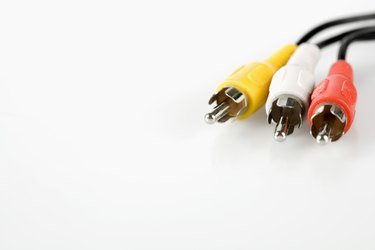
Rapid technology advances in the home entertainment industry bring new terminology that may be confusing. To simplify the terms used for the many cables that connect audio and video components together, manufacturers, marketers and users tend to name them by their uses or the types of connectors on the ends. But neither method specifically identifies either an RCA cable or a subwoofer cable.
Defining RCA Cables
Video of the Day
The term "RCA cable" identifies any type of coaxial cable with RCA push-in connectors on the ends. Developed in the 1940s by Radio Corporation of America, an RCA cable originally carried a signal from a phonograph to an amplifier. But today they connect audio and video signals between components of home entertainment systems, including audio and video amplifiers and switches, satellite and cable receivers, DVD players and TV screens. Manufacturers use RCA connectors on various qualities of coaxial cable for different applications up to 100 MHz. Some low-power speakers use RCA cables, but most use pairs of wires.
Video of the Day
Exploring Subwoofer Cables
A subwoofer cable connects an audio amplifier to a speaker designed to reproduce low-frequency sound signals up to 100 Hz. Whether the connection requires a pair of wires or an RCA cable depends on the design features of the particular system. The subwoofer may be passive (without any internal amplification), or active (with an internal amplifier included to increase the volume). For a subwoofer with an RCA connector, any RCA cable will carry the signal. But some manufacturers add special features to an RCA cable and label it "subwoofer."
With recent innovations in audio technology, you will likely be able to find affordable, powerful subwoofers that do not rely on RCA cables. 1/4" jacks are becoming a ubiquitous element of "consumer-grade" audio hardware, meaning that a large number of consumers today may never actually need to work with RCA cables at all. That being said, this will depend entirely on the subwoofer cable and system being used.
RCA Subwoofer Cables
The electrical characteristics of a coaxial cable depend on the diameter of the center conductor, the type and thickness of the insulating material and the type of shield used. A more elaborate shield reduces unwanted signals induced in the cable. RCA connectors can be used on a wide variety of coaxial cables with various quality specifications. RCA cables labeled "subwoofer" may have tighter woven fibers in the mesh of the shield or a second or third shield made of mesh or foil. Gold plating the connectors on a subwoofer cable improves conductivity and prevents corrosion, but it doesn't reduce AC hum.
Assessing the Causes of AC Hum
Household electricity operates at 60 Hz and can produce an unwanted hum in speaker systems in two ways: induction into the speaker cable from other equipment or wiring, or from a ground loop where the 60 Hz hum travels on the shield of a coaxial cable. Since hum falls withing the frequency range of a subwoofer, the problem is more prevalent there. Extra shielding in an RCA cable to a subwoofer may reduce hum caused by induction, but not by a ground loop. An isolation transformer for the AC input to the entire sound system may break a ground loop.